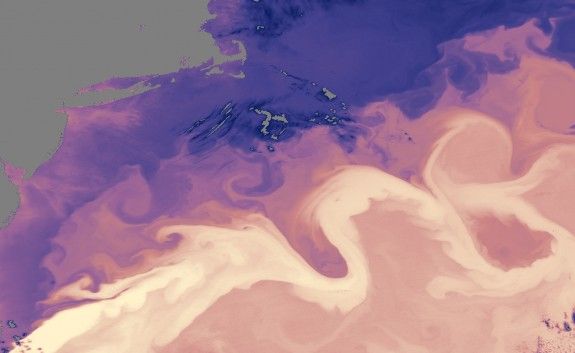Europe Is Warmer Than Canada Because of the Gulf Stream, Right? Not So Fast
A long-accepted explanation for a warm Europe is up for debate
/https://tf-cmsv2-smithsonianmag-media.s3.amazonaws.com/filer/2013021812302102_18_2013_gulf-stream-50th.jpg)
Take a gander at this map, and you’ll see the red line marking the 50th parallel, a line of equal latitude that runs a full circle around the Earth. Every point on this line is the same distance from the equator, and the same from the frozen pole. And yet the weather on the left side of the map, in the Canadian province of Newfoundland and Labrador, is vastly different from the right, in the United Kingdom. Winter temperatures in Ireland, says Scientific American, are about 36 F warmer than they are in Newfoundland.
To make sense of this disparity, the common tale—the one bandied around for more than a hundred years—goes something like this: Warm water flowing to the northeast out of the Gulf of Mexico—the Gulf Stream—cuts across the North Atlantic ocean, bringing extra energy to the Isles and driving up temperatures relative to the comparatively-frigid North Americas. The only problem with this simple explanation, say Stephen Riser and Susan Lozier in Scientific American, is that it doesn’t actually account for the difference.
In the 19th century geographer and oceanographer Matthew Fontaine Maury was the first to attribute the relatively mild climate of northwestern Europe to the Gulf Stream.
… Maury surmised that the Gulf Stream supplies heat to the overlying westerly winds that move across the Atlantic toward northwestern Europe. He also speculated that if the Gulf Stream were somehow diminished in strength, the winter winds would be much colder and that Europe would experience Arctic-style winters. Over the years Maury’s idea became almost axiomatic—and until recently, it also remained largely untested.
In climate modeling studies where the Gulf Stream was artificially swept out of existence, the temperature differences between eastern Canada and western Europe persisted.

So what’s really going on? According to Riser and Lozier, the cause of the temperature difference is likely a complex interaction between the surface ocean, the Gulf Stream, massive upper atmospheric currents and differences in pressure on either side of the Atlantic.
But the other, more interesting side of the story, is the tale of the Gulf Stream explanation. Where did it come from, and how did it hold up for so long?
After Matthew Fontaine Maury came up with his idea, posits scientist and blogger Chris Rowan, the explanation went on to become, in essence, a scientific “urban myth.”
According to Seager, the notion that the Gulf Stream was warming Europe can be traced back to a book first published in 1855, and is “the climatological equivalent of an urban legend”. It is certainly persistent enough, although given that this particular “fact” has been promulgated not by a friend’s sibling’s cousin’s friend over a pint on a Friday evening, but by scientists and educators in newspapers, televison programmes and lectures, it’s arguably even more pernicious. But how did this happen? Isn’t science meant to be self-correcting?
By the intricacies of scientific publication, a conjecture put forth in one research paper can, through time, become accidentally morphed into a statement of fact through the peer-reviewed equivalent of the game “telephone:”
Here’s how it can happen. In the introduction to your average paper, you’ll often see sentences along the lines of:
The link between and has long been known (Bloggs, 1996).
The implication is that everyone knows and accepts this, so it’s not worth wasting time going through the evidence in painstaking detail; but if you’re interested, you can look up the given reference for the gory details. Most of the time, this is exactly what you get when you track the given reference down; but sometimes, you find that it is nothing more than the oldest reference to this fact that the original paper’s author was willing or able to look up, and all it says is:
There is strong evidence that and are linked (Obscuro, 1982).
If you persist further, you may find yourself going through the process of looking up a reference, only to be directed to an even earlier one, several more times before you finally reach the canonical document, the one that contains actual data and discussion. And this is what you find:
Based on collected using and assuming , we conclude causes .
More from Smithsonian.com:
/https://tf-cmsv2-smithsonianmag-media.s3.amazonaws.com/accounts/headshot/smartnews-colin-schultz-240.jpg)
/https://tf-cmsv2-smithsonianmag-media.s3.amazonaws.com/accounts/headshot/smartnews-colin-schultz-240.jpg)